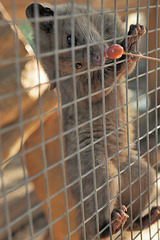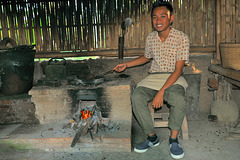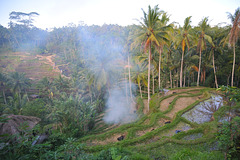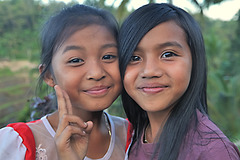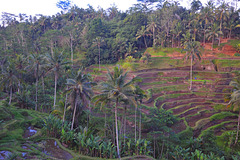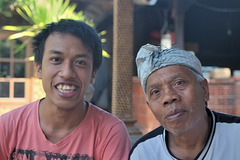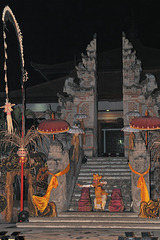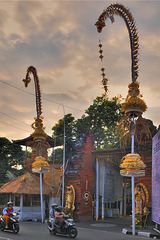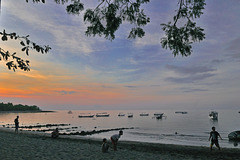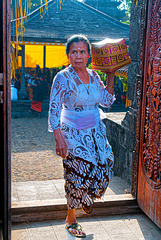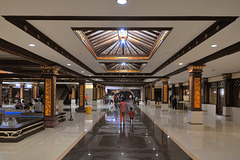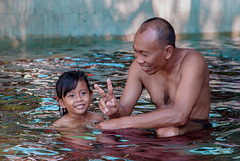
Return to Bali the island of demons
Luwak in the cage eating coffee berries
| |
|
Meanwhile its a common business on Bali to produce the Kopi Luwak and for this reasons people are holding the Luwak animal encosed in cages.
Most people keep the meaning the expensive coffee is the product of cats but this is absolute an hooey. Cats never eat coffee cherries, cats eat fish and meat.
The Luwak is an animal like a weasel or the Asian palm civet - never a cat!
Here I post my photo captured in Bali Pulina a famouse Coffee plantage nearby Ubud.
(Its very difficult to get the Luwak in front of the camera in the wild, the animal moving very fast and seen only at night. But its reprehensible too to keep the animals in cages just for making business with the most expensive coffee.)
Roasting most expensive coffee in the world
| |
|
Kopi luwak or civet coffee is a coffee made from the beans of coffee berries which have been eaten by the Asian Palm Civet and other related civets, then passed through its digestive tract.
A civet eats the berries for their fleshy pulp. In its stomach, proteolytic enzymes seep into the beans, making shorter peptides and more free amino acids. Passing through a civet's intestines the beans are then defecated, keeping their shape. After gathering, thorough washing, sun drying, light roasting and brewing, these beans yield an aromatic coffee with much less bitterness, widely noted as the most expensive coffee in the world.
The boy is roasting fresh beans for preparing a cup of coffee for us.
Paddyfield terraces in Ceking-Tegalalang
| |
|
Bali is famouse for the beautiful and majestic rice terraces. One of them is Ceking-Tegalalang nearby Ubud.
The farmers burn the rice straw making new soil for better crop yields.
Anjeli and Chandra
| |
|
|
Two smart and cute young girls got photographed after selling postcards.
In Bali child labor its common to increase income of their family, the girls were selling postcards to me. The work is ok as long as children go to school and parents care for their education.
My drawer is full with picture postcard showing the beauty of Bali, but I bought some and made this ducky picture with the charming girls.
Paddyfield in Ceking
| |
|
Ceking nearby Ubud is one of the most important destinations for an amazing landscape view.
The rice terrace is designed very beautiful with exquisite hollowing rice field and precisely located on the hill bank. In this place, we saw the Balinese farmer do their rice field in oblique area complete with its system irrigation
Mask of Celuluk
| |
|
|
My Balinese friend Anom showing me the mask of Celeluk which was created by the great master I Made Tonggu in Gianyar.
A Celeluk is an assistant to Rangda, the witch and the demon queen of the leyaks in Bali, according to traditional Balinese mythology. The Celuluks taking care of her cleaning, cooking, and generally taking care of Rangda herself.
My hosts for more than a decade
| |
|
I Made Kardit and his youngest son Purnaysa Ega.
The father is my hosts since 2001. The Balinese family let me to join the daily life in their house, in the village and in temples where I learned much about Balinese livingstyle and their souverain Hinduism.
Legong performance at the Art Festival
| |
|
Legong is a refined dance form characterized by intricate finger movements, complicated footwork, and expressive gestures and facial expressions.
Legong probably originated in the 19th century as royal entertainment. Legend has it that a prince of Sukawati fell ill and had a vivid dream in which two maidens danced to gamelan music. When he recovered, he arranged for such dances to be performed in reality. Girls from the age of five aspire to be selected to represent the community as Legong dancers.
Penjor decoration beside the mainroad
| |
|
At Galungan time, Balinese Hindus erect a Penjor in front of their houses to symbolise the dominance of good (dharma) over evil (adharma), as well as offering thanks to God for the fruits of the Earth. About halfway down the pole they attach a small cage in the shape of a triangle and made from bamboo, called sanggah cucuk. Offerings are placed in this and it is considered to be a temporary “throne” for the Gods when they come down to Earth for Galungan. If you take a close look at a Galungan penjor, you’ll notice that it’s also ornamented with coconut leaves called sampian and also long strips of white and yellow material to symbolise that it is a holy offering.
At the beach in Pemuteran
| |
|
The beaches are especially nice in this area and consist of a particularly fine grained black sand.
The small village Pemuteran was my startingpoint for four divetours to the underwater templegarden and to the corallwall in Menjangan.
Young worshipers come to Pura Ponjok Batu
| |
|
Before entering the holy compound of the temple I photographed this three young ladies carring the small boy in one girls hip.
The girls wear the necessary yellow scarf (Selendang) around their hips and are dressed in traditionel clothes. A Pedanda priest pressed the tilak (some rice corns, called bija) on their foreheads. Its an external symbol of our surrender to Krishna (central figure of Hinduism, or to our object of worship).
Worshiper woman enters the temple complex
| |
|
Balinese woman in her traditionel dress steps into the holy complex of Pura Ponjak Batu a temple in the village Desa Pacung 60 km east of Singaraja in northern Bali.
Inside the holy yard of Pura Ponjok Batu
| |
|
The external and middle parts of the temple was accessible tme after a Balinese guide let me the necessary clothes to enter the hoy center. The madya mandala (middle part) has a bale pegat (open air pavilion) surrounded by a beautiful pool. The hall is regarded as a transition space for those who wish to practice worshiping in the central part of the temple.
Inside the Pura Ponjok Batu
Taman Budaya Denpasar
| |
|
Taman Budaya means the park of art. Its the culture building complex with the best style of Balinese traditional architecture.
Here inside the exibition hall where many manufactors display their art products in small boots.
Balinese among themselves
| |
|
This happy group of youngsters I captured in a pool in Air Sanih.
A person in Bali cannot exist in solitude. Balinese society is very community oriented.
In modern Bali these customs are normally not strictly observed, so I could see Balinese youngstern having fun together in the pool like here.
But visitors visiting Balinese temples are strictly advised to dress in the traditionell clothes and cover their legs with sarongs or saputs.
Cute water lovers look out
| |
|
|
Two girls get snapshooted in the pool of Air Sanih in northern Bali.
The public bath with natural water, not far from Singaraja, is liked very much by local Balinese people and a paradies for small kids.
Girl taught by her father learns to swim
| |
|
|
Captured in Air Sanih nearby Singaraja in the northern part of Bali.
Bali is known to have happiest children, happy because of love and care all time. Material happieness is insignificant.
Jump to top
RSS feed- Latest items - Subscribe to the latest items added to this album
- ipernity © 2007-2024
- Help & Contact
|
Club news
|
About ipernity
|
History |
ipernity Club & Prices |
Guide of good conduct
Donate | Group guidelines | Privacy policy | Terms of use | Statutes | In memoria -
Facebook
Twitter

